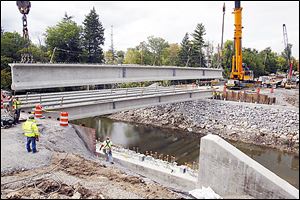
Gas tax is user fee
2/20/2013
Workers install beams for a bridge on Perrysburg-Holland Road in Toledo. A higher state gas tax could accelerate road construction and repair.
Ohio needs to jump-start highway and bridge repair or suffer the fate of Michigan, where motorists pay $81 more a year to fix their cars, on average, than Ohioans do. A higher state tax on motor fuels is not politically popular, but it’s the fair and efficient thing to do.
Michigan roads have degraded to the point that officials estimate the state needs to spend $1.4 billion a year just to keep them from getting worse. To keep Ohio from such a downward spiral, Gov. John Kasich wants to borrow $1.5 billion against future Ohio Turnpike tolls. The administration says that sum will enable the state to collect another $1.5 billion in federal matching funds for much-needed transportation projects.
The idea is worth exploring, but it would provide just a one-time infusion of cash and could put an excessive burden on northern Ohio. It also would sidestep Ohio’s constitutional debt limit.
Ohio’s 28-cent-a-gallon tax on gasoline hasn’t risen since 2005, although the state’s road-repair needs have increased over that period. Meeting those needs requires a continuing money source.
Few if any taxes come so close to being a direct user fee as do fuel taxes. Higher gas prices encourage consumers to use less fuel. They are more apt to combine trips, carpool, and keep their vehicles tuned up. They’re more inclined to use public transportation. All of these things have the ancillary benefit of curbing air pollution, which keeps down public health costs.
How much the gasoline and diesel fuel taxes should be raised depends on how much money the state transportation department needs to make urgent repairs.
It also will depend on how much of a burden lawmakers want to impose on Ohioans through less-equitable funding mechanisms, such as borrowing against future turnpike tolls, playing shell games with other funds, or cutting other state-provided services.
The transportation department has cut 500 jobs since Governor Kasich took office in 2011, while the state must do more road work. Among the affected workers was a travel counselor assigned to an I-75 rest area near Bowling Green, who last year helped authorities apprehend a man who was suspected of kidnapping two teenage girls.
Mr. Kasich lauded the employee for his efforts. Months later, he was reassigned to another job and the position he held at the rest area was eliminated.
Ohio needs more money for urgent road and bridge work. The question is whether state officials will maintain an illusion of fiscal austerity by rejecting any consideration of higher fuel taxes — that is, user fees.